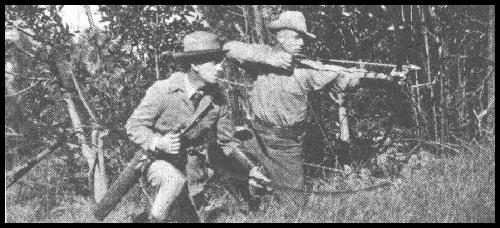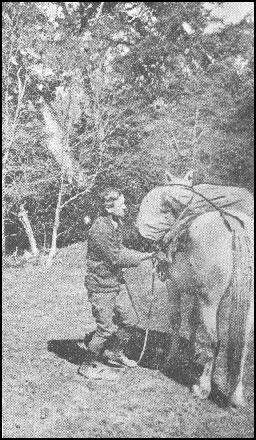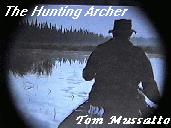
In the field of archery the romatic figure of Dr. Pope
has been an inspiration to a legion of bowmen who now carry on to ends
no man dream ed of fifteen years ago. It was my happy fortune to know him
during the last five years of his life. I want to tell one or two things
of this acquaintance to "Ye Sylvan Archer."

His home in San Francisco was a beautiful one. In the library was a fireplace before which he sat evenings and worked on bows aad broadheads. At the right of his chair was a small table; in a drawer of this were a plane, some sandpaper, a small rasp, and a sharp knife. Many times I have watched the delight with which he studied the tricky problems of yew. One night as he was finishing a bow for a far away enthusiast, he said to me, "Well, I guess that will do for that man. Any way, it is just as good as the one I made for you, and it seemed to be all right for your purposes." I must say it was good enough for me, putting it very mildly. I hunted with it for years, very happy years. It now hangs on my wall, beside the brown fur of a bear nide through which it cast a broadhead like a dagger through smoke. It belongs to the memory of Dr. Pope and is very sacred. Archers who visit my home handle and shoot it; this is as its maker wished. He told me that he wanted to have it used.
In the basement of Dr. Pope's home was a work bench, with a vise and lathe. Here he cut the joints or his bows, and roughed them out; with the lathe he shaped arrow shafts, using a~piece of sandpaper in his bare hand. In his attic, whither you were led, very solemnly, by the light of a candle, lay a supply of yew staves, seasoning. He was mighty careful there should be no danger of his house taking fire, for if it burned, these staves would be lost with it.
During the two years I spent in he mountains of Northern California Dr. Pope visited me several imes, for hunting purposes. It was hard for him to pass by an opportunity of this sort. He loved that beautiful land of sky-piercing trails. He once told me that he only existed from one hunt to the next.
In spring these uplands are a paradise; grass, clover, and golden flowers cover the sunny openings. In my second April there I wrote Dr. Pope that he should be out among them with his bow. A letter came at once saying he could not possibly leave his patients. The invitation, however, had infected him with wilderness fever; in four days more he wrote again, saying he would be up the next day. I drove down into the lowlands to meet him; he got off the train with his bow and quiver and packsack in the first light of morning.
At my home we loaded a pack horse with food, bedding, and dishes, and led the animal a half days travel on upwards. A log cabin on a tiny flat at the head of a tremendous mountain pasture made our camp. We hobbled the horse, and became aborigines. The three days we spent there were ones full of a harmony I shall never be able to de scribe.

Deer crept from cover to nibble grass, a bow shot from our door. A spring came from the ground just north of us and below it the soil, well watered and soft, made a place to practice shooting where no arrows were broken. Each morning after dishes were washed our broadheads tore up the sod for a half hour's drill. Then we unstrung our bows, sat down in the sun and filed our arrow heads to a clean hair edge; then put them back in their quivers for the day's hunt.
Dr. Pope's tackle was beautifully made. The appearance of his bow spelled serious work, for serious use. It was backed with rawhide; the horn nocks were graceful and powerful. His arrows, carried in a deerhide quiver slung from his belt, were perfection; straight, stiff, and accurately feathered. He used a large pinion, a full five inches long, because he preferred steadiness "to having his arrow fly so far it would land in another country." He never urged mc to change to his ideas; experience has done so. Now I use a stcadier arrow and my hits are much more consistent.
On his hunting belt was also a poueh with wax, file and an
extra string; and in a sheath, a beautiful dagger brought from the Orient
by his brother, Ben. I assure you he was a striking figure. He shaved every
day in camp, and kept as neat and trim as he did before his classes in
surgery. Well in his fifties he appeared less than forty years old. He
stood about five feet and seven inches tall; he was very erect in posture,
and had the most graceful walk I have ever noticed in a man. It seemed
as though he was a shadow gliding, rather than a man moving on foot.
During this outing our days were planned to give us hunting
and a trip into some good scenery. The second day we traveled over Ruff's
Ridge down into into Van Duzen Canyon, where he and Arthur Young got their
first bear. We ate lunch, made tea, and rested an hour. Then we went down
the Little Van Duzen river to Summit Valley Trail, where I had some yew
staves cut in January snow. I took one on my shoulder; we reached camp
after dark.
In the third evening as we moved along a deer trail at the edge of a rushy canyon, we were rewarded by hearing the heavy growl of a wild cat in snawer to my imitations of a "wounded rabbit squall." Fortune sent to the nostrils of the feline a swirl of breeze from our direction; he scented us and vanished.
This trip netted us no trophies for our walls, but I have a clear picture of those blue hazy mountains in the warm sunlight, a treasure in my memory. It is possible that I shall again hear the mountain quail send his flute notes piercing the shadows of late dusk, or that the raven's weird bugle shall wake me again to as beautiful daylight; I believe that will be only in the Happy Hunting Grounds when I camp there with Doctor Pope.
In the front of my copy of "Hunting With the Bow and Arrow" is inscribed the following in his own lettering: "April--1924--On an cxpedition to Monte's Cabin--Hunting yew staves, bob cats and ground squirrels.
